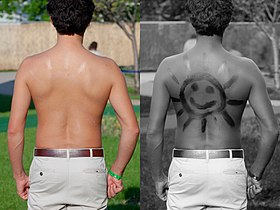
Back واق شمسي Arabic ছানস্ক্ৰীণ AS Crema solar Catalan Opalovací krém Czech Eli haul CY Solcreme Danish Sonnenschutzmittel German Αντιηλιακό Greek Sunprotektilo EO Protector solar Spanish
| Sunscreen | |
|---|---|
 Sunscreen on back under normal and UV light | |
| Other names | Sun screen, sunblock, sunburn cream, sun cream, block out[1] |
Sunscreen, also known as sunblock,[a] sun lotion or sun cream, is a photoprotective topical product for the skin that helps protect against sunburn and prevent skin cancer. Sunscreens come as lotions, sprays, gels, foams (such as an expanded foam lotion or whipped lotion[4]), sticks, powders and other topical products. Sunscreens are common supplements to clothing, particularly sunglasses, sunhats and special sun protective clothing, and other forms of photoprotection (such as umbrellas).
Sunscreens may be classified according to the type of active ingredient(s) present in the formulation (inorganic compounds or organic molecules) as:
- Mineral sunscreens (also referred to as physical), which use only inorganic compounds (zinc oxide and/or titanium dioxide) as active ingredients. These ingredients primarily work by absorbing UV rays but also through reflection and refraction.[5][6]
- Chemical sunscreens, which use organic molecules as active ingredients. These products are sometimes referred to as petrochemical sunscreens since the active organic molecules are synthesized starting from building blocks typically derived from petroleum.[7] Chemical sunscreen ingredients also mainly work by absorbing the UV rays.[8] Over the years, some organic UV absorbers have been heavily scrutinised to assess their toxicity[9] and a few of them have been banned in places such as Hawaii[10] and Thailand[11] for their impact on aquatic life and the environment.
- Hybrid sunscreens, which contain a combination of organic and inorganic UV filters.
Medical organizations such as the American Cancer Society recommend the use of sunscreen because it aids in the prevention of squamous cell carcinomas.[12] The routine use of sunscreens may also reduce the risk of melanoma.[13] To effectively protect against all the potential damages of UV light, the use of broad-spectrum sunscreens (covering both UVA and UVB radiation) has been recommended.[3]
As of 2021, only zinc oxide and titanium dioxide are generally recognized as safe and effective (GRASE) by the U.S. Food and Drug Administration (FDA)[14] since there is currently insufficient data to support recognizing petrochemical UV filters as safe.
- ^ "Preventing melanoma". Cancer Research UK. Archived from the original on May 22, 2008. Retrieved September 22, 2009.
- ^ Moddaresi, Mojgan (October 20, 2017). "EU SPF Regulations: Labelling and claims". Prospector Knowledge Center.
- ^ a b Cite error: The named reference
fda2011was invoked but never defined (see the help page). - ^ "WHIPPED FORMULATIONS WITH DESIRED SENSORY IMPACT". Canada Patent Data Base. July 8, 2022. Archived from the original on July 8, 2022. Retrieved July 8, 2022.
- ^ Cole, Curtis; Shyr, Thomas; Ou-Yang, Hao (October 2, 2015). "Metal oxide sunscreens protect skin by absorption, not by reflection or scattering". Photodermatology, Photoimmunology & Photomedicine. 32 (1): 5–10. doi:10.1111/phpp.12214. ISSN 0905-4383. PMID 26431814. S2CID 20695063.
- ^ Schneider, Samantha L.; Lim, Henry W. (November 16, 2018). "A review of inorganic UV filters zinc oxide and titanium dioxide". Photodermatology, Photoimmunology & Photomedicine. 35 (6): 442–446. doi:10.1111/phpp.12439. ISSN 0905-4383. PMID 30444533. S2CID 53562460.
- ^ Dinardo J, Downs C (April 2021). "Failure to Protect: Do Sunscreens Prevent Skin Cancer in Humans?". ResearchGate.
- ^ Ko SA (September 2016). ""Physical" vs. "chemical" sunscreens and other sunscreen myths". KindofStephen. Archived from the original on January 9, 2022. Retrieved January 9, 2022.
- ^ Tian L, Huang L, Cui H, Yang F, Li Y (October 2021). "The toxicological impact of the sunscreen active ingredient octinoxate on the photosynthesis activity of Chlorella sp". Marine Environmental Research. 171: 105469. Bibcode:2021MarER.17105469T. doi:10.1016/j.marenvres.2021.105469. PMID 34500299. S2CID 237469500.
- ^ Suh S, Pham C, Smith J, Mesinkovska NA (September 2020). "The banned sunscreen ingredients and their impact on human health: a systematic review". International Journal of Dermatology. 59 (9): 1033–1042. doi:10.1111/ijd.14824. PMC 7648445. PMID 32108942.
- ^ Chatzigianni M, Pavlou P, Siamidi A, Vlachou M, Varvaresou A, Papageorgiou S (November 2022). "Environmental impacts due to the use of sunscreen products: a mini-review". Ecotoxicology. 31 (9): 1331–1345. Bibcode:2022Ecotx..31.1331C. doi:10.1007/s10646-022-02592-w. PMC 9652235. PMID 36173495.
- ^ "Skin Cancer - Skin Cancer Facts - Common Skin Cancer Types". www.cancer.org. Archived from the original on April 10, 2008.
- ^ Sunscreens and Photoprotection at eMedicine
- ^ Research, Center for Drug Evaluation and (November 16, 2021). "Questions and Answers: FDA posts deemed final order and proposed order for over-the-counter sunscreen". FDA.
Cite error: There are <ref group=lower-alpha> tags or {{efn}} templates on this page, but the references will not show without a {{reflist|group=lower-alpha}} template or {{notelist}} template (see the help page).